| Tweet | Follow @OphirGottlieb |  |  |

FUEL is trading $15.39, down 3.3% with IV30™ down 1.9%. The Symbol Summary is included below.
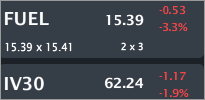
Provided by Livevol
Rocket Fuel, Inc. is a technology company that has developed an Artificial Intelligence and Big Data-driven predictive modeling and automated decision-making platform.
Conclusion
The stock has plummeted while at the same time, the risk in the stock price as reflected by the option market has fallen to near all-time lows. While revenue growth is booming, book value is rising and gross margin % is high and rising, the firm is hemorrhaging in losses and still pays ~$1.10 for every $1 in operating revenue.
Is this the profile of a firm that has low risk moving forward?
The all-time stock chart is included below.
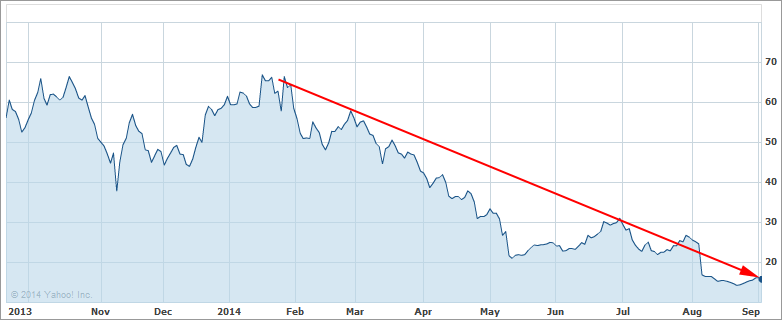
Provided by Yahoo! Finance
The stock peaked at around $65 and has fallen rather abruptly to ~$15. There were pockets of equity appreciation, nearly a 50% rise from May to July, but ultimately the stock is near all-time lows.
Let's take a look at the risk priced into the future stock price. The IV30™ chart in isolation, below.

Provided by Livevol
The implied volatility is the forward looking risk in the equity price as reflected by the option market (IV30™ looks forward exactly 30 calendar days).
In English, the red curve is the risk in future stock price movement. I have drawn that yellow line to show the current level of 'risk' relative to the past. The current level is in the 12th percentile, i.e. low. I find that odd, although, everyone reading has heard me repeat that ad nauseum to this point surrounding several firms (see 'recent Posts' for more).
I find risk in the firm fairly simply in the financial measures. Here are five charts which make me think, 'huh?' In Ophir language, 'huh?' means risk.
Revenue
So this is an easy one. Revenue has been increasing linearly without fail. very good news.

Gross Margin %
FUEL's gross margin % has always looked pretty nice. Even better, the margin % is increasing over time as revenues are increasing. That's a pretty good trick on management's side.
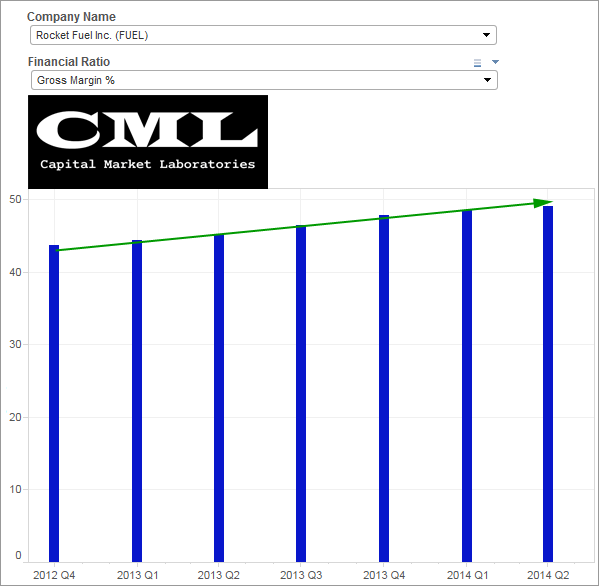
Operating Revenue / Operating Expenses
I love this financial measure. Simply stated, a firm's Operating Revenue:Operating Expense must by greater than 1 for the firm to reach a profit. At this point, FUEL is ~0.9, but the real issue is that the ratio is not increasing. FUEL is paying ~ $1.10 for every dollar in revenue in receives.
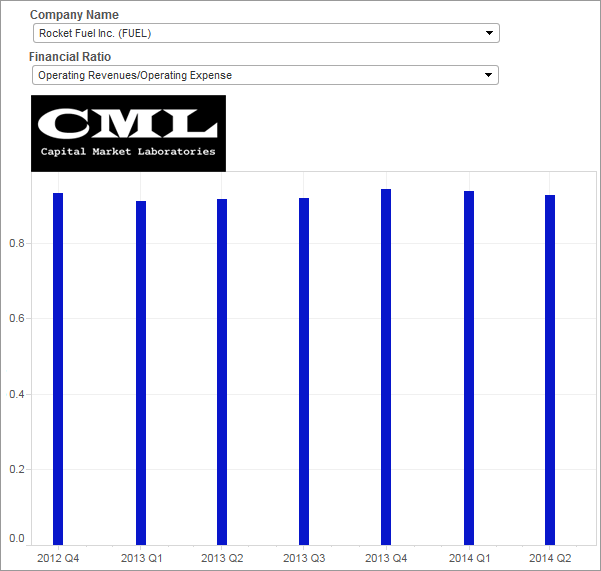
Net Income
So, this is sort of 'the truth' measure. FUEL earnings have been plummeting. For a young firm that has booming revenue, this is hardly a death nail, but... it also can't be totally ignored. Even more interesting is that FUEL is showing increasing revenue with increasing gross margins, yet Net Income continues to fall. That's a tough trend to swallow.
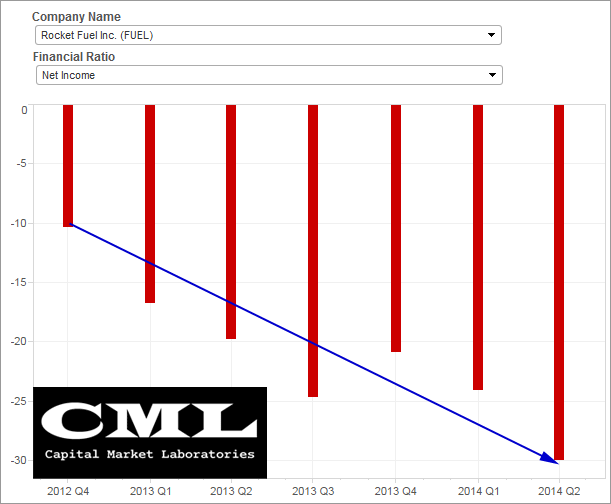
Book Value
Book value has been increasing, and in fact has risen from ~-$3 to now over $7. That's a solid trend.
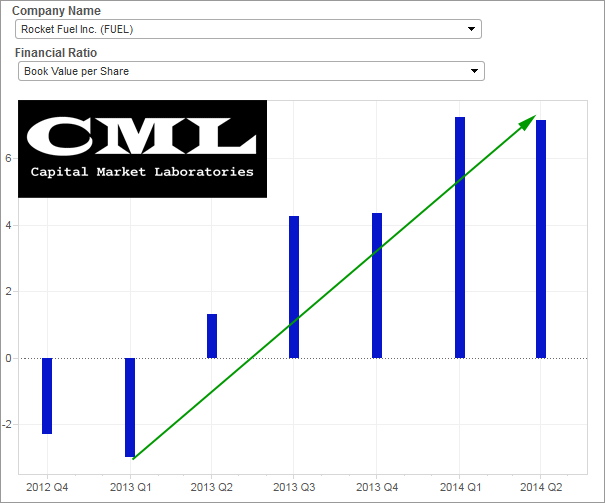
So what?... Well, what I see in this firm is a lot of 'good' and a lot of 'bad.' That divergence or lack of equilibrium means risk. Add tot he fact that the stock price has swung rather dramatically in the midst of a longer term collapse, and I just don't see this as low risk.
Finally, the Options Tab is included below.
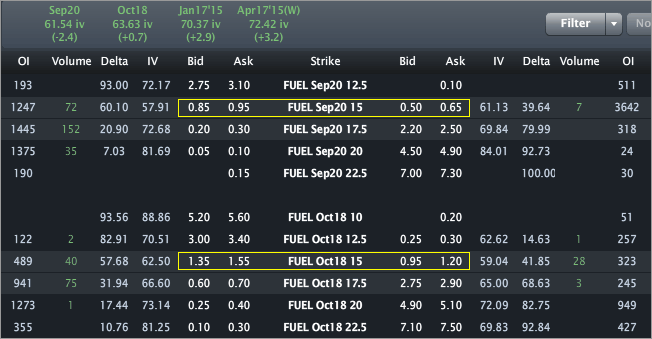
Provided by Livevol
Explicit Risk Pricing
Using the at-the-money (ATM) straddle we can see that the option market reflects a price range of [$13.50, $16.50] by the end of trading on Sep. 19th.
We see a price range of [$12.50, $17.50] by the end of trading on Oct 17th.
- If you believe the stock will be outside that range on expiry or any date before then, then you think the volatility is too low.
- If you believe that range is too wide, and that the stock will definitively be in that range on expiration, then you think volatility is too high.
- If you're not sure, and can make an argument for either case, then you think volatility is priced just about right.
This is trade analysis, not a recommendation.
Follow @OphirGottlieb
Tweet
Legal Stuff:
Options involve risk. Prior to buying or selling an option, an investor must receive a copy of Characteristics and Risks of Standardized Options. Investors need a broker to trade options, and must meet suitability requirements.
The information contained on this site is provided for general informational purposes, as a convenience to the readers. The materials are not a substitute for obtaining professional advice from a qualified person, firm or corporation. Consult the appropriate professional advisor for more complete and current information. I am not engaged in rendering any legal or professional services by placing these general informational materials on this website.
I specifically disclaim any liability, whether based in contract, tort, strict liability or otherwise, for any direct, indirect, incidental, consequential, or special damages arising out of or in any way connected with access to or use of the site, even if I have been advised of the possibility of such damages, including liability in connection with mistakes or omissions in, or delays in transmission of, information to or from the user, interruptions in telecommunications connections to the site or viruses.
I make no representations or warranties about the accuracy or completeness of the information contained on this website. Any links provided to other server sites are offered as a matter of convenience and in no way are meant to imply that I endorse, sponsor, promote or am affiliated with the owners of or participants in those sites, or endorse any information contained on those sites, unless expressly stated.


No comments:
Post a Comment